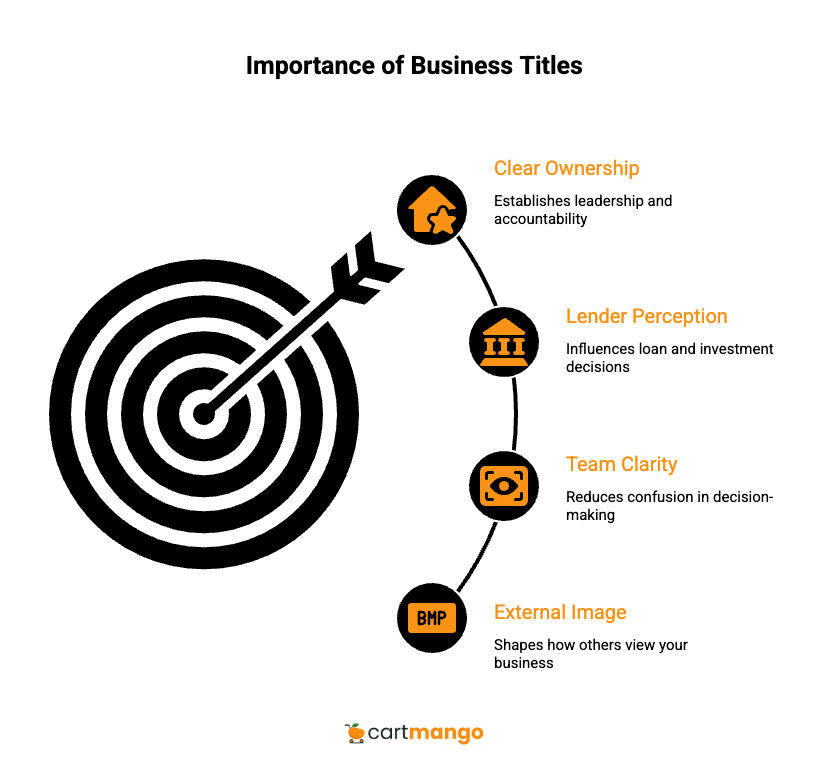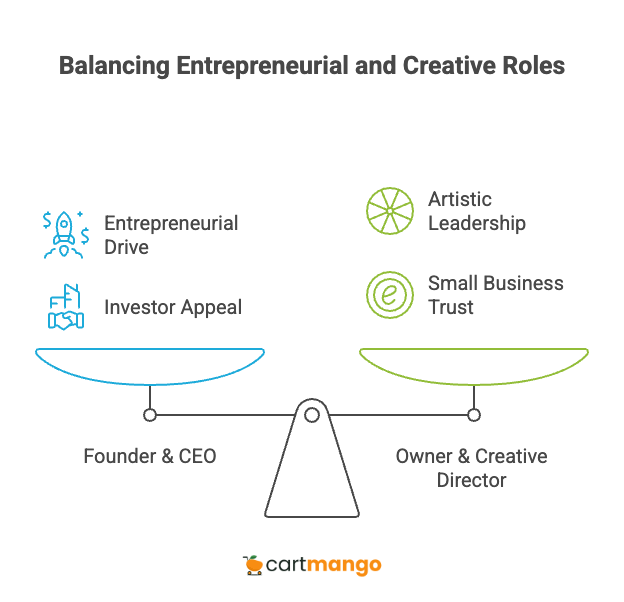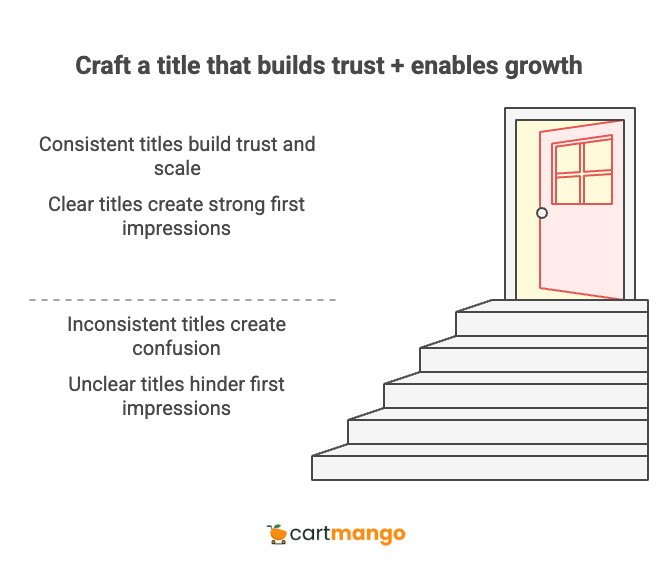Picking the right title as a small business owner helps people understand your role and makes you look more credible to customers, partners, and lenders. You can go with a simple, classic title or choose something fun that matches your business vibe.
–
For the 1 uncommon title + 14 titles, jump to this section.
–
Why Your Title Matters
Many business owners treat their title as an afterthought. They slap “owner” on their business card and call it a day.
But here’s what they don’t realize. Your title plays a key role in how lenders and investors perceive your business.
.
Business titles shape perception. So does your customers’ checkout experience. Grab a CartMango account for $0/month + 0% commission (totally free) & discover how smooth the buying process can be for your customers.
.
Many lenders look for titles that clearly indicate ownership or leadership when evaluating loan applications.
Clear titles also help teams avoid confusion when making decisions. Your employees need to know who makes the final call.
Think about it. When someone sees “Chief Fun Officer” on your invoice for a $50,000 contract, what goes through their mind? Perhaps they’re wondering if you’re serious about business. Maybe they start questioning whether you can deliver on your promises.

1 Uncommon + 14 Titles for Small Business Owners
Title | Best For | Watch-Outs |
|---|---|---|
Uncommon Title | Brand-driven startups – e.g. Head of First Impressions, Master of Coin, Wizard of Lightbulb Moments | May hurt credibility |
Owner | Sole proprietors | Can sound informal |
Founder | Origin-story branding | Doesn’t show current duties |
CEO | Firms seeking capital | Feels “too big” for solo operations |
President | B2B credibility | Implies larger org chart |
Managing Director | International clientele | Misread as “manager” in U.S. |
Principal | Consulting & creative shops | Unclear to laypeople |
Managing Member | LLCs (legal accuracy) | Jargon outside legal docs |
Director of Operations | Hands-on operators | Suggests someone else is CEO |
Creative Director | Design/marketing studios | Industry-specific |
Technical Director | IT & SaaS boutiques | Narrow if you pivot |
Proprietor | Retail/hospitality heritage | Dated in tech |
General Manager | Multi-location franchises | Lacks ownership signal |
Chairperson | Firms with boards | Overly formal for micro-businesses |
Chief X Officer | Niche authority – e.g., Chief Innovation Officer, Chief Wellness Officer, Chief Sustainability Officer | Can confuse banks/insurers |
Owner works when you’re starting out. Simple, direct, honest. But banks sometimes see it as small-time thinking.
Founder tells your origin story. You built this from nothing. The problem? It doesn’t show what you do now. Are you still coding? Managing? Strategizing?
CEO opens doors with investors and lenders. It screams authority and growth potential. But if you’re a team of one, it might feel like putting on a suit that’s three sizes too big.
President works well for B2B services. Contractors love it. It suggests structure without the startup baggage of “Founder.”
Managing Director confuses Americans but Europeans expect it. If you’re selling internationally, this title feels familiar to UK and EU clients.
Principal fits consulting firms like a glove. Lawyers, architects, and creative agencies use it naturally. Outside those industries, people scratch their heads.
Managing Member appears on your LLC paperwork anyway. Legal documents require accuracy here. But customers don’t understand the jargon.
Director of Operations tells everyone you’re in the trenches daily. Great for hands-on businesses. The downside? It implies someone else runs strategy.
Creative Director works perfectly for design studios and marketing agencies. It signals artistic authority. Just don’t use it for accounting firms.
Technical Director fits IT consultancies and SaaS startups. It shows expertise. But what happens when you expand beyond tech services?
Proprietor gives retail and hospitality businesses a heritage feel. Think family bakeries or boutique hotels. It sounds quaint in Silicon Valley.
General Manager suggests you run multiple locations. Perfect for franchisees. Terrible for showing ownership.
Chairperson works when you have an actual board of directors. For solo operations, it’s like wearing a crown to the grocery store.
Chief X Officers let you get creative while staying professional. Chief Innovation Officer signals forward-thinking. Chief Wellness Officer fits health-focused brands. Chief Sustainability Officer works for eco-conscious companies. The risk? Banks and insurance companies get confused by non-standard titles.
Fun Titles can work in the right context. Chief Disruptor, Head of First Impressions, Chief Fun Officer, Master of Coin, Wizard of Lightbulb Moments. These grab attention at conferences. They fall flat with traditional lenders.
–
The pattern here is simple. Match your title to your audience.
Selling to Fortune 500 companies? Go traditional. Targeting creative millennials? You have more flexibility.
But remember this. Your title appears everywhere. Business cards, LinkedIn, loan applications. Pick something that works across all these contexts.
Decide Your Title by Asking 3 Questions
Stop guessing and use practical criteria to pick your title. Focus on these 3 questions to simplify your choice.

Key Question | What to Consider | Example Choice |
|---|---|---|
Strategic vs. Operational? | Do you set direction or run daily tasks? | Founder (strategy) vs. Director of Operations (execution) |
Primary Audience? | Who must be convinced first? | CEO for investors, Owner for retail shoppers |
Scalability? | Will the title still fit after hiring or funding? | Start as Owner, evolve to CEO |
Question 1: Strategic vs. Operational?
This one cuts to the core. Are you the person setting company direction? Do you spend your days thinking about market trends, competitive positioning, and long-term planning? You’re strategic. Founder, CEO, and President fit here.
Or maybe you’re neck-deep in daily operations. You’re fulfilling orders, managing projects, solving customer problems. Director of Operations, General Manager, and Principal work better.
Question 2: Primary Audience?
Your most important relationships should guide this choice.
- Chasing venture capital? VCs expect to see CEO or Founder on your business card. They’re pattern-matching to successful startups they’ve funded before.
- Serving local retail customers? Owner feels trustworthy and approachable. People like buying from business owners, not corporate executives.
- Selling B2B services? President carries weight in procurement departments. It suggests you have authority to negotiate and close deals.
The mistake I see constantly? Picking a title that impresses you instead of your audience. Your ego doesn’t sign the checks.
Question 3: Scalability?
Think three years ahead. Will your chosen title still make sense? Starting as “Owner” works fine initially. But if you plan to raise funding or hire executives, you’ll need room to grow.
CEO gives you that runway. You can add a COO, CFO, and other C-level positions later. Owner doesn’t scale as cleanly.
But maybe you never want to scale beyond a boutique operation. Then Owner might be perfect forever.
Combining Titles

Dual titles can sometimes work.
Dual Title | Who Should Use It |
|---|---|
Founder & CEO | Funding-ready startups |
Owner & Creative Director | Design studios |
Managing Partner & CFO | Multi-partner firms |
Founder & Lead Developer | Micro-SaaS makers |
Owner & Head Barista | Cafés/roasters |
Dual titles satisfy multiple search patterns. Someone looking for a “creative director” and someone searching for a “business owner” both find you.
.
Solo business owners juggle a lot – titles, products, customer questions. You know what shouldn’t be complicated? Your checkout. Claim your CartMango account for $0/month + 0% commission (totally free) & start selling in 1 minute.
.
Founder & CEO tells your complete story. You built this company from nothing, and now you run it strategically. Investors love this combination because it shows both entrepreneurial drive and executive capability.
Owner & Creative Director works perfectly for design studios. The “Owner” part builds trust with small business clients. The “Creative Director” part attracts larger companies looking for artistic leadership.
Managing Partner & CFO open doors at professional service firms. It shows you have business partners (credibility) and financial expertise (competence).
Founder & Lead Developer dominates the micro-SaaS space. It tells potential customers you built the product yourself and still understand the technical details.
Owner & Head Barista might sound silly, but it works for specialty coffee shops. Local customers want to buy from someone who actually knows coffee.
Best Practices for Dual Titles
1/ Keep each part under 25 characters.
Business cards have limited space. Nobody wants to read a novel on your card.
2/ Put the strategic word first.
“Founder & Lead Developer” ranks better than “Lead Developer & Founder” in most algorithms.
3/ Use identical wording everywhere.
Your website, LinkedIn headline, email signature, and business cards should match exactly. Consistency builds trust.
Don’t Make These 4 Mistakes

Avoid pitfalls that can undermine your credibility. Some trendy titles may sound fun but confuse lenders and scare off potential partners.
Brilliant business owners can torpedo their credibility with bad title choices. Learn from their mistakes.
1/ The trendy label trap
“Ninja,” “Rockstar,” “Guru,” and “Wizard” might get laughs at networking events. But hiring managers often view them as red flags. They signal immaturity and lack of business sense.
2/ The inflation problem
Don’t claim “Manager” when you manage nobody. Don’t use “CFO” if you don’t sign financial statements. These lies catch up fast when people dig deeper.
Imagine this:
Peter is a “VP of Sales” at a three-person company try to close a major deal. The prospect asked to speak with other VPs to understand the organizational structure. Awkward silence followed.
3/ Regional differences matter
Region | Feels Normal | Feels Odd |
|---|---|---|
U.S. | CEO, President | Managing Director |
U.K./EU | Managing Director | President |
Asia-Pacific | Director, Founder | Chairperson (small firms) |
Americans expect CEOs and Presidents. We’re comfortable with executive titles even at small companies. “Managing Director” sounds foreign and confusing here.
But flip the script in London. “Managing Director” is the standard executive title. “President” makes British clients think of political leaders, not business executives.
If you’re selling internationally, pick titles that work in your primary market.
4/ Legal restrictions
Some states restrict words like “Bank,” “Trust,” or “Insurance” in business titles. Check your local regulations before committing.
Fun titles create another problem. They charm conference audiences but confuse SBA loan officers. Consider maintaining a formal secondary title for legal documents while using your creative title for marketing.
Understanding Your Company’s Managerial Structure
Your business owner title choice depends heavily on your company’s managerial structure and business structure. Many small business owners wear multiple hats, handling everything from day to day operations to long term strategy.
The chief executive officer and chief financial officer represent common business owner titles in larger organizations. But as a sole owner, you might prefer a less formal title that fits your company culture. Your job title should accurately reflects what you actually do.
Traditional vs. modern approaches
A formal title like president title or managing director title works well when you need to establish clear operational leadership. The chief operating officer title fits perfectly if you’re deep in the company’s operations daily. These traditional titles help other employees and new departmental managers understand who has the final say in decision making.
But maybe your business culture calls for something different. A less formal title can work when it matches your industry norms and company’s goals. The key is picking the perfect title that serves as the driving force behind how potential clients and involved parties see your leadership role.
Structure-based considerations
Limited liability companies and sole proprietorships have different needs for business owner title picking. In a sole proprietorship, you truly are the sole owner with complete control over technical aspects and operational management. An executive director title might feel too corporate here.
The ceo title carries weight across all business structures. It signals that you handle the big picture while departmental managers focus on specific areas. This c level title works whether you’re managing a security solution company or any other business type.
Certain titles work better for specific legal entity types. Your best title should align with both your company’s operations and how you want involved parties to perceive your role. The right business owner title becomes part of your identity and helps clarify your leadership role to everyone you work with.
A great title supports your company’s goals while reflecting the reality of your multiple responsibilities. Whether you choose other titles or stick with tried-and-true options, make sure it captures your role as the driving force behind your organization’s success.
Your Turn

Your title is a five-second credibility test. Every prospect, lender, and potential employee forms an opinion before you say a word.
Pick a title using the three-question decision matrix. Strategic or operational? Who’s your primary audience? Will it scale with your growth plans?
Update every touchpoint today. Social profile, website bio, email signature, invoices, business cards. Consistency builds trust. Confusion kills deals.
Want a shortcut? Create a simple worksheet with the framework questions. Plug in your answers and lock in a title you can grow with.
The first impression starts the moment someone reads your name and title. Make it count.
While a strong title kicks things off right, the actual sale happens when your customer checks out. Join CartMango for $0/month + 0% commission (totally free) & make your sales process as smooth as your branding.
Related
- SendOwl vs SamCart: The Recurring Revenue Jail (2026)
- ThriveCart vs ClickFunnels: When more features hurt (2026)
- SendOwl vs Payhip: The “You-Leave-You-Lose” Model (2026)
- SamCart vs Kajabi: The Income Hostage Trap (2026)
- Sellfy vs Payhip: The Recurring Revenue Prison (2026)
- Podia vs Gumroad: The Recurring Revenue Handcuffs (2026)
- SendOwl vs Gumroad: The Recurring Revenue Black Hole (2026)
- Gumroad vs Sellfy: The Vendor Lock-in Cage (2026)
- Gumroad vs Payhip: The Hidden Trap for Creators (2026)
- ThriveCart vs SamCart – The Subscription Hostage Trap (2026)
